 |
|
. |
|

Email us at
info@coastal181.com |
|
BACK
TO PHOTO OF THE DAY HOME PAGE |
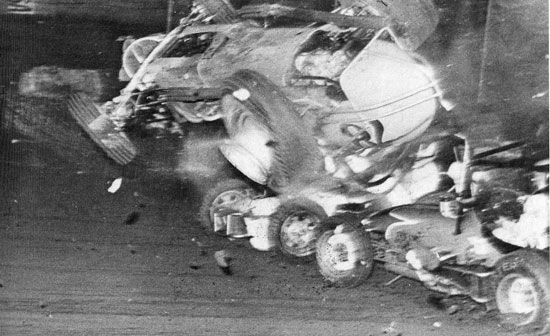
| |
| Bob Meli took his CRA sprinters
into the turns so hard he was nicknamed “Back ‘Em In” Bob.
But this time, on April 10, 1967, his entry at Ascot was
really over the top. It cost him his spleen and several
weeks in the crash house. (From Racing Pictorial, 1976
Summer Edition. Tom MacLaren Photo) |
|

| |
| These are the age-old Nazareth
half-mile Fairgrounds track and Nazareth National, the one
and one-eighth mile dirt oval built alongside it by Jerry
Fried in 1966. Fried was a grainy, carnie-type promoter who
certainly had his detractors during his long run in
Pennsylvania. No one, however, could ever question his
vision. He even had plans to put a roof over Nazareth
National. In later years the place was purchased by Roger
Penske, but he couldn’t make a go of it, either. (Dale
Snyder Photo) |
|

| |
| Mark Martin first appeared in
NASCAR in the early eighties, toting an impressive resume of
championships in the Midwest. He didn’t look that fresh,
however, after going the distance in the Wrangler 400 at
Richmond. Here he pours in the pure oxygen. These days, at
51, he has been called the best driver never to win a Sprint
Cup Championship – and certainly one of the most physically
fit in the pit area. (From GRAND NATIONAL STOCK CAR
RACING – the Other Side of the Fence, by Randy Hallman
with Linda Vaughn.) |
|
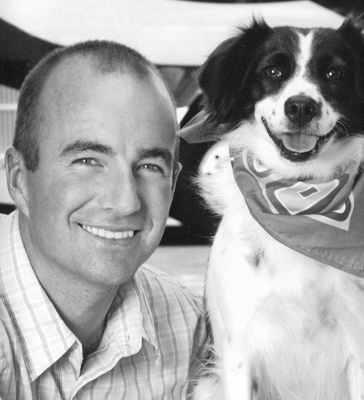
| |
| How about that Marcos Ambrose!
He has taken the racing community by storm with his uncommon
driving ability and his wry sense of humor. He says, “Being
from Tasmania, a lot of people think I had a pet kangaroo
growing up. I joke around and tell people that I did, and
that I used to ride in its pouch to school when I was a
little boy. But, in all honesty, my pets have been cats and
dogs.” He’s shown here with his rescue pooch, Dora, a
four-year-old mixed terrier. (From
PIT ROAD PETS – NASCAR Stars and their Pets, by
Wendy Belk. Photo by Karen Will Rogers.) |
|
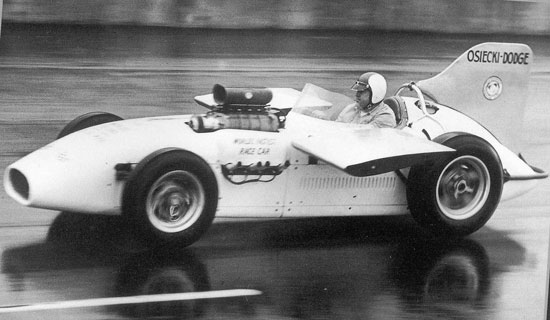
| |
| Bob Osiecki’s Dodge,
piloted by dragster Art Malone, went around Daytona
International at 181.561 mph in 1965, winning him $10,000
for a new closed-course speed record. He knew the car would
really be flying. It had wings and a rudder. Remarkably,
that same year, LeeRoy Yarbrough muscled a largely
stock-bodied Dodge Coronet around the Tri-Oval at 181.818.
(From
PROVING GROUND – A History of Dodge, Chrysler, and Plymouth
Racing by Jim Schild. Photographic Archives of
C.A.R.S.) |
|
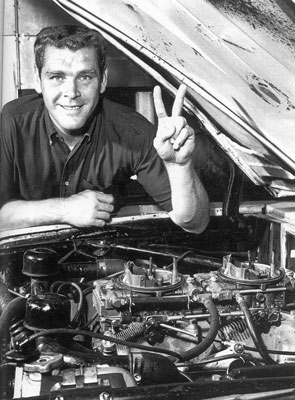
| |
| Buddy Baker was looking pretty
psyched up next to a 426 Hemi back in 1968. NASCAR was
considering allowing dual Holley four-barrels on the
superspeedways that year. They decided not to do so, even
though the energy crisis was still a few years away. (From
PROVING GROUND – A History of Dodge, Chrysler, and Plymouth
Racing
by Jim Schild. Photographic Archives of
C.A.R.S.) |
|
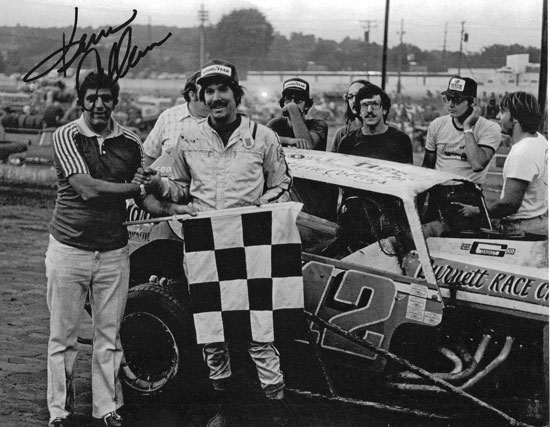
| |
| Kevin Buskirk is the musician
behind Ron Hornaday. Kevin is Crew Chief of Delana Harvick’s
#33 Camping World truck. He’s been making music for a long
time, as shown here with his injected big block modified on
his way to the 1977 Championship at the old Nazareth (PA)
Raceway. Back then his name was “Kevin Collins.” (Boyd
Collection) |
|
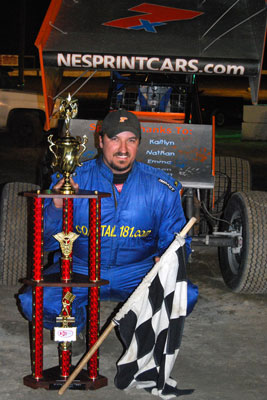
| |
How about those Coastal 181
drivers? A couple of weeks ago we had a photo of the day of
Blake Shepard, wheelman of the Coastal 181 modified. Blake
and his wife Ericka, the “Dzus Queen,” had just had twin
daughters. Seems that Danny Douville, driver of the Sargent
Service/Coastal 181 sprinter owned by Mike Kondrat, couldn’t
stand being outdone. He had triplets. Over Labor Day
weekend, SCoNE (Sprint Cars of New England) had a gala
championship series at three separate tracks, Canaan, NH;
Bear Ridge, VT; and Big Daddy’s Speedbowl in NH. Danny won
all three of them.
(Don Mac Photo) |
|

| |
Timothy Peters cut some very
fast laps a few years back at South Boston. He was track
champ in 2004, and he did some near perfect ones with his
bubbly, too, in celebration. Today he is a hittin’ his marks
in the Red Horse Racing entry in the NASCAR Camping World
Truck Series. From
South Boston Speedway – The FIRST 50 Years.
(Alan
Moore/Turn 1 Photography) |
|
 |
| |
| Now that Carl Edwards
career has gone skyward, he has rock star status and a
totally cosmopolitan aura. He started here on earth, though,
and in the early days, as shown here at Missouri ‘s Capital
Speedway in 2000, his image was a bit more understated. Same
smile, though. (From
Where Stars Are Born, Celebrating 25 Years of NASCAR Weekly
Racing, by Paul Schaefer. NASCAR News Archive/Russ
McCoy Photo) |
|
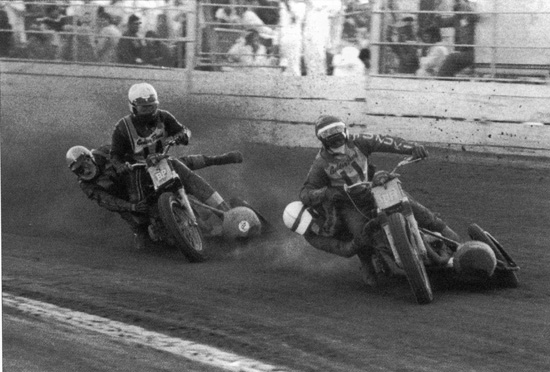
|
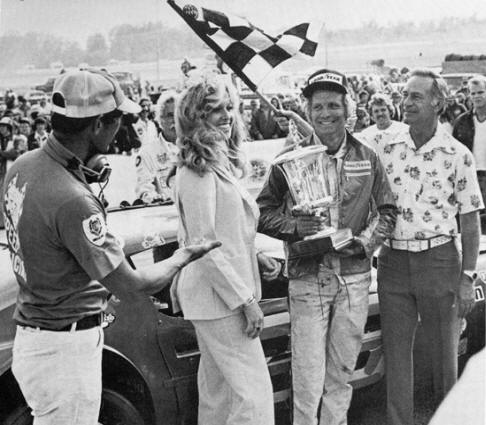
| |
| One of the most popular and
successful late model racers out of the Wisconsin area in
the 1970s was Larry Detjens. He ran with great success
against such notable gassers as Tom Reffner, Dick Trickle,
and Alan Kulwicki. One of his most memorable wins was this
one, the World Cup 400 at I-70 in 1977. He perished in a
crash at Wisconsin International Speedway in 1981. (From
Racing Pictorial Fall 1977) |
|

| |
| Leading a race is an acquired
skill. Waldo Barnett didn’t get it at all right while he was
out front at the Valley County Fair in Ord, Nebraska in
August 1947. He looked back to see who followed, sideswiped
the wall, and flipped. Here he is tended to, lying on the
straightaway, but he died on the way to the hospital. (From
Valley County Thunder, The History Of Racing At Ord,
Nebraska, by V. Ray Valasek and Bob Mays, Ed
Swopes Photo) |
|
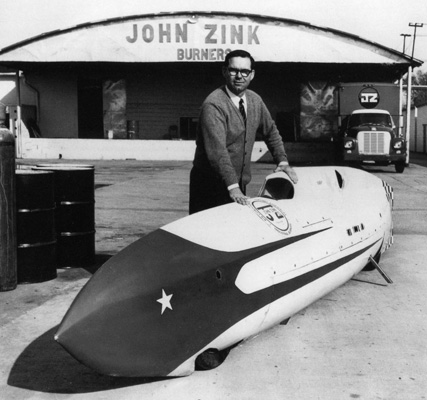
| |
John Smith “Jack” Zink said,
“The man who wins is the man who tries.” That rang true for
the talented Zink in business, in stock cars, supers, and
Indy cars. It did not work so well in this effort, however.
He hoped to set a world record with this bullet shaped two
wheeler, but it turned out to be unstable at speed. (From
To
Indy and Beyond,
The Life of Racing Legend Jack Zink,
by Dr. Bob L.
Blackburn) |
|
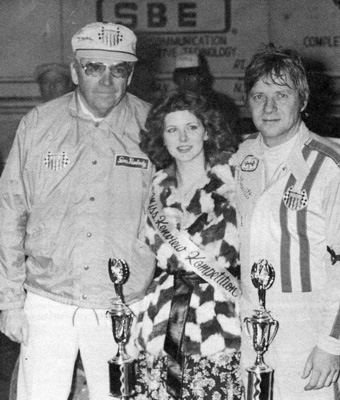
| |
| Eddie Leavitt beat out Ron
Shuman and Dick Tobias to win the USAC sprint show at
Reading, PA, on April 22, 1978. Presenting him the laurels
were Cindi Johnson, Miss Kenview Kompetition, and USAC
Sprint Supervisor Don Peabody. The next day Don died in a
plane crash with seven other USAC folks and the pilot. (Joe
DeLong Photo – Racing Pictorial 1978 Summer) |
|
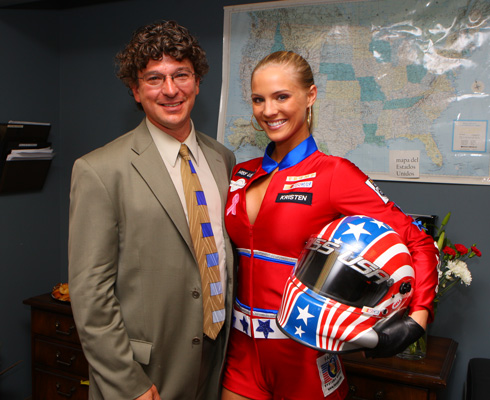
| |
| Andrew Giangola’s new book
The Weekend Starts on Wednesday (see Photo of the
Day of Jim Cramer last week) sure is drawing attention. A
recent admirer of his work is Miss USA, Kristen Dalton. We
are of course delighted for our friend Andrew, NASCAR’s
Director of Business Communications, but we have to ask
ourselves where Kristen was when we launched
Hot Cars Cool Drivers here at Coastal
181... (Giangola Collection, Getty Images) |
|
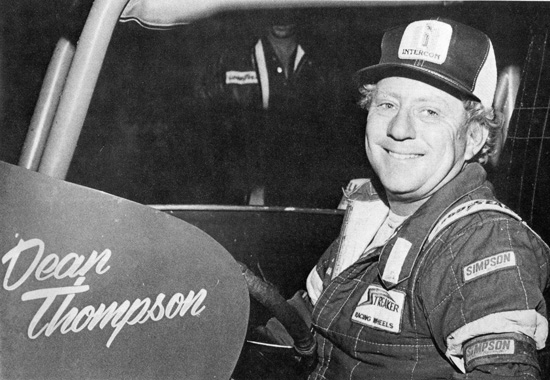
| |
| Dean Thompson was arguably CRA’s
all-time best with 103 victories. Fact is, the ultra-popular
Deano simply was not bilaterally symmetrical. One arm was
shorter than the other – and, no question, his right foot
was heavier than his left. He got into the turn so deep it
was like it was never there. He died in heart surgery in
October 2003 at age 53. (Tom MacLaren Photo from
Racing Pictorial 1982-83) |
|

|
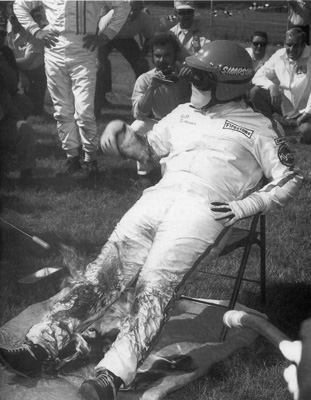
| |
| Bill Simpson put his legs where
his mouth was. He showed up and off at Indy in 1970 with his
latest in fire protection. From RACING SAFELY, LIVING
DANGEROUSLY by Bill Simpson with Bones Bourcier. (IMS
photo) |
|

| |
| It looks like this old-time ice
racer was a “cut-off” rather than a “cut-down.” In any case,
it sure looked cold. (R.A. Silvia Collection) |
|
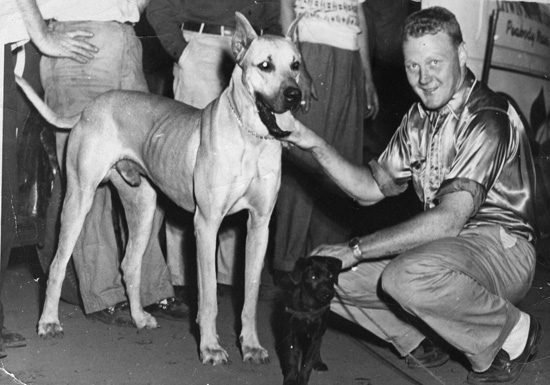
| |
| Have you ever
wondered what how big some of those huge advertised purses
actually are when they are described as “total posted
awards?” Do you think New England Hall of Famer Red Cummings
knew he had a Great Dane coming at the payoff window at
Norwood Arena back in the early fifties? In any case, Red’s
daughter Gael remembers that her Dad took it in stride.
“Champ” became a beloved member of the family. (Cummings
Family Scrapbook) |
|

| |
| Paula Flemke Bouchard, Eddie’s
daughter, hitches a ride to Victory Lane with her husband
Ron after he snookered Darrell Waltrip and Terry Labonte to
win the Talladega 500 in 1981. (Photo from Linda Vaughan’s
1982 collaboration, Grand National Stock Car Racing, The
Other Side of the Fence) |
|
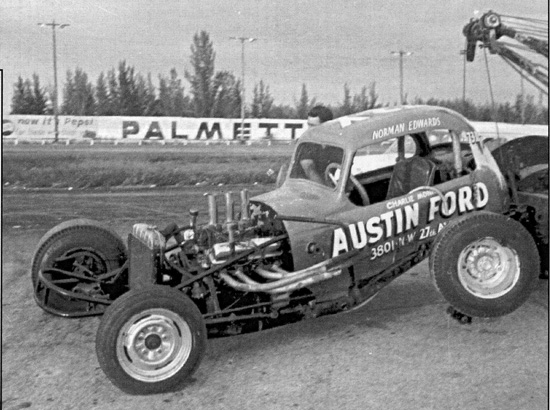
| |
| Charlie Monk wadded up
this early super at Palmetto, Florida. It was built by Gil
Hearne, and it looks like Gil had a little more welding to
do. (Bobby 5x5 Day Photo from
Florida Motorsports Retrospective Pictorial, Volume
2, by Eddie Roche) |
|

| |
| Korean War Veteran, Dewayne
Louis “Tiny” Lund was one huge man. The 1963 Daytona winner
ran over 300 Cup races before dying at Talladega on August
17, 1975. Two Vietnam vets watching in the infield rushed
out and pulled him from his burning car, but it was too
late. (Racing Pictorial, 1975 Summer Edition) |
|
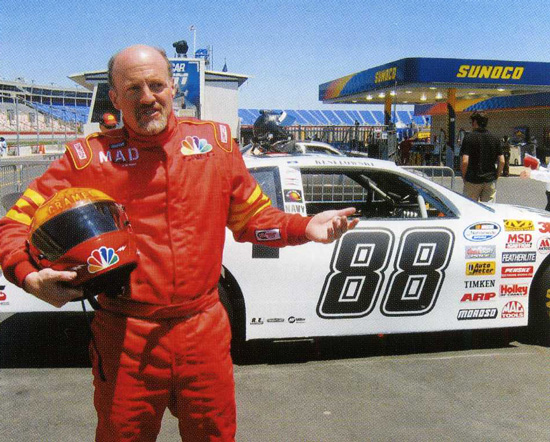
|
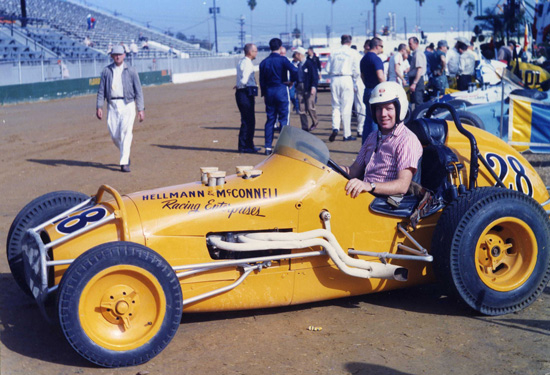
| |
Florida’s Will Cagle
has raced and won endlessly since the 1950s, all over the
country, in every kind of hot rod imaginable. Here he is at
Tampa, back before insurance companies knew what to look
for. He was last seen on national TV following a podium run
in one of the features in the recent Legends car fest at
Charlotte. He was looking silvery-haired but very fast, and
he is busily seeking a superspeedway ride.
(Brad Poulsen
Collection) |
|
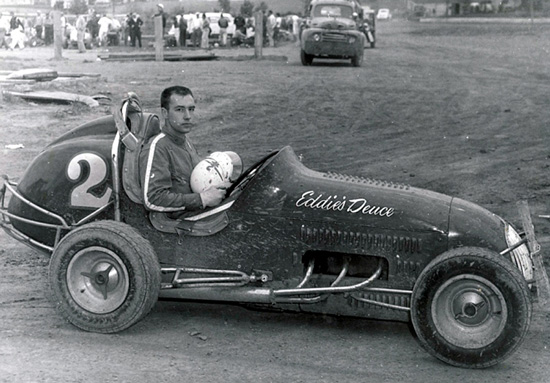
| |
| Ed Clothier, a champion New York
state boxer, took a fling at racing midgets in the 1960s. It
lasted for eternity. In 1965, he came to the ultra-high
banks of the old quarter-mile Westboro (MA) Speedway, right
near Worcester, for a NEMA event. He flipped mightily along
the top of the wooden guardrail and died. (Dave Dykes Photo)
|
|

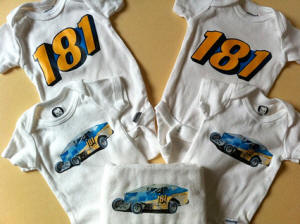
| |
| Blake Shepard, our friend and
driver of the Coastal 181 modified, and his wife Ericka (aka
“the Dzus Queen”) sure have their hands full these days.
Gracelyn and Colbie are doing great – so well, in fact, that
Blake will have to be ordering a couple of pink quarter
midgets in a month or so. They will be togged out in their
one-eighty-onesies, designed by Dad. |
|
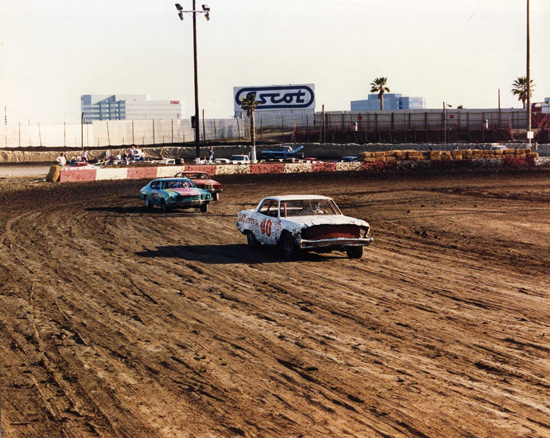
| |
Whatever a photo of Ascot may
show, whatever cars were on the track, it will forever bring
sadness deep to the heart of a dirt tracker.
(Earl
Stubbs Photo, Brad Poulsen Collection) |
|
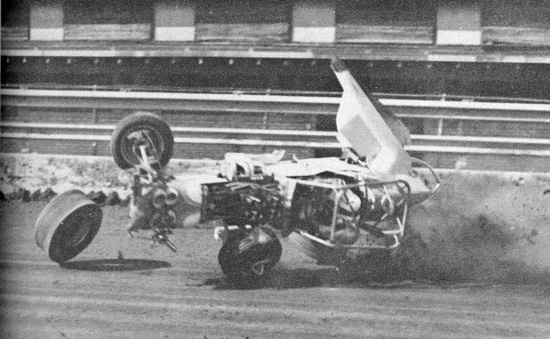
| |
The great Jim Hurtubise had one
bad day on October 7, 1977. He got into turn three too hot
on his first qualifying lap at the Salt City 100, a USAC
Champ Dirt Car show, and flipped big time. Larry Dickson
went on to grab the $6800 paid to the winner.
(Joe DeLong
Photo, Racing Pictorial, 1977-78 Annual) |
|
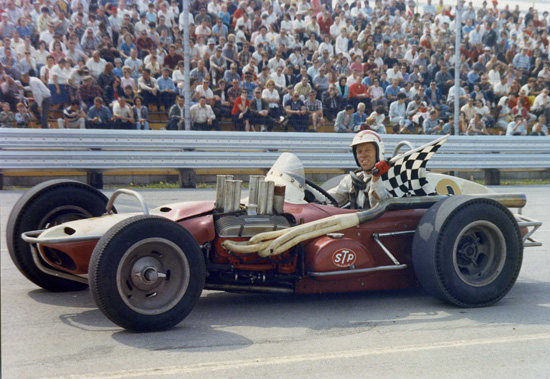
| |
| Open wheel and open air. That’s
Tom York winning a qualifier at Sandusky, Ohio back in 1966.
(Brad Poulsen Collection) |
|
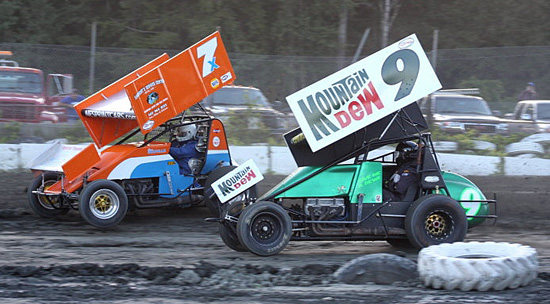
| |
| Other than the strong 50 year
efforts by the Northeast Midget Association (NEMA), there
hasn’t been that much open wheel racing in the Northeast.
That’s changed this summer. The hottest thing in the area is
SCONE, Sprint Cars of New England. Feisty, well-populated
fields run quite regularly at tracks like Bear Ridge in
Vermont and Canaan Fairgrounds and Big Daddy’s Speedway in
New Hampshire. Guess it’s back to basics! (Don Mac photo) |
|

| |
| Here he was, honing his manual
skills in 1957 while sanding down a dragster. Johnny
Rutherford got good behind the wheel, too. He would win Indy
three times. From
LONE STAR J.R., by Johnny
Rutherford and David Craft. |
|
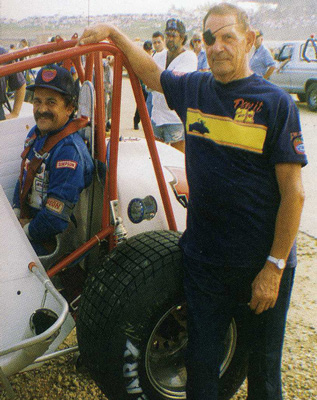
| |
| Genes are something. Sometimes
they seem to race through a generation using the same line.
How about Kirk Douglas and his son Michael. Or George Bush
Sr., our 41st President, and his boy “W”. Then, of course,
at Eldora, there was Don Hewitt and his son “Do It”, aka
Jack. From
EARL!, by Earl Baltes with Dave Argabright. (John
Mahoney Photo) |
|

| |
| It’s Charlotte, way back in June
of 1948. A novice driver named Lee Petty entered his first
Grand National, “new car” race in a Buick Roadmaster loaned
to him by a neighbor. The sway bar broke on the heavyweight
four-door, and Petty barrel-rolled it four times. Probably a
little explaining to do….. From THE CARS OF RICHARD
PETTY, by Tim Bongard and Bill Coulter. (Photo from the
Richard Petty Private Collection) |
|
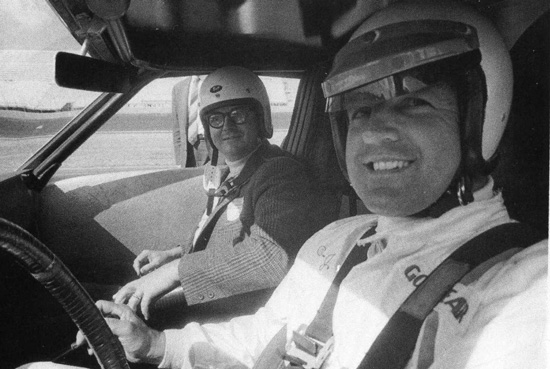
| |
| Look at that A.J.
grin as he prepares to take a couple of laps at Michigan.
And look at Chris Economaki along for the ride. Do you think
he looks scared? He should. From
LET ‘EM ALL GO, by Chris Economaki with Dave
Argabright. |
|

| |
| He looked like a
typical 10-year-old when he won trophies showing quarter
horses. But 15 years later, it was one flamboyant, dashing
Tim Richmond who hauled hardware out of Winston Cup victory
lanes. From
TIM RICHMOND, THE LIFE AND REMARKABLE TIMES OF NASCAR’S TOP
GUN, by David Poole. (Photo Courtesy of Sandy
Welsh) |
|
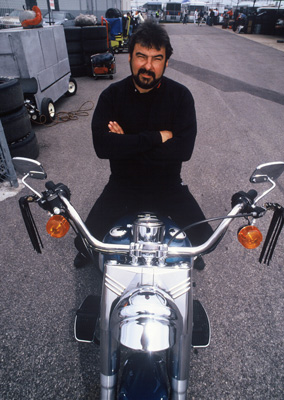
| |
| It’s Danny “Chocolate” Meyers in
biker mode. Danny was Dale Sr.’s gas man for 15 years,
retiring when Dale died. (Dick Berggren Collection) |
|
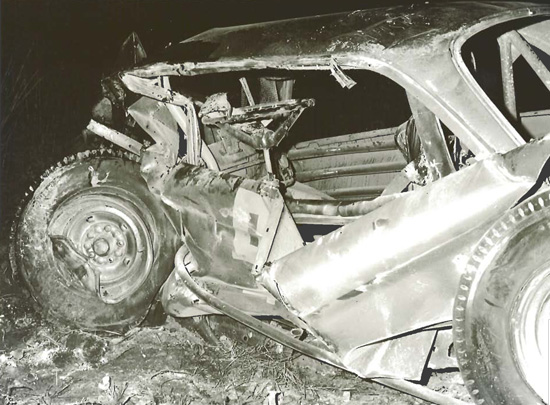
| |
June 30, 1968 at Thompson,
Connecticut. Two big winners, Bill Slater and
Fats
Caruso, crashed and burned in one of the most spectacular
wrecks ever in the Northeast. Both were very seriously
injured, but both would return to racing and both were
eventually inducted into the New England Auto Racing Hall of
Fame. This is what Fat’s car, the $ sign owned by Johnny
Stygar, looked like when the smoke cleared. (Steve Dahl
Collection) |
|
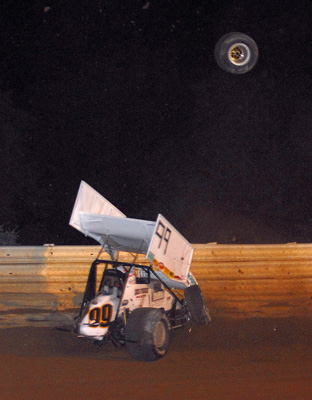
| |
Rubber moon over Selinsgrove.
Frank Simek, the familiar “Guy with the Hat,” has been
producing amazing images for decades. Here he captures
gasser JJ Grasso, 2009 URC champion out of Pedricktown, NJ,
shedding some parts.
(Frank Simek Photo) |
|
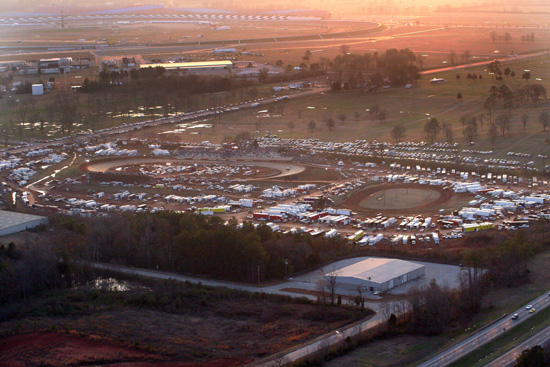
| |
| A soft sunset over some hard
racing. That’s the Ice Bowl goin’ on at the Dirt Track at
Talladega a few Januarys back. The go-kart track is to the
right, and the superspeedway looms in the background.
(Preacher Phillips Collection) |
|

| |
Reno, Nevada’s Ed Evans ran this
sprinter in California in the late seventies. Everything
about the operation seemed over-sized. Maybe that’s because
it was sponsored by a brothel. (From
HISTORY OF SAN JOSE AUTO RACING,
by Dennis
Mattish (Dennis Mattish Photo) |
|

| |
| Here he is, the one and only,
bodacious and bionic, Bentley Warren at his newest place of
business, Bentley’s Saloon in Arundel, Maine. What more can
you say? (Dick Berggren Photo) |
|
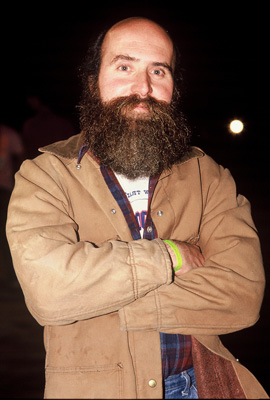
| |
| Goober Scheidel was, bar none,
one of dirt modified racing’s absolute favorites in the
seventies. The affable Connecticut racer, a school bus
mechanic by trade, raced on nearly 50 tracks, never spending
a dime because he never had one. It’s hard to know whether
the competitors in the pits or the kids in the grandstands
cheered for him more loudly. Then leukemia took him away in
September 1993. Thinking of you, Goob. (Dick Berggren
Collection) |
|
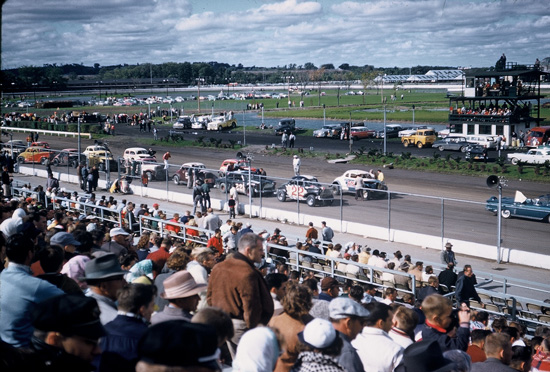
| |
| It was a
hundred-lapper at Syracuse, N.Y., on September 28, 1958, one
third of the way back to the Civil War. The conflict was
still heated. On the pole from North Carolina was
gentlemanly Ned Jarrett in Dink Widenhouse’s infamous B-29
coupe, while edgy Pete Corey out of Cohoes, NY, lined up on
the outside in the equally notorious flaming #22. The trophy
this day would go back to the Southlands. (Dick Berggren
Collection) |
|

| |
| Bob Bahre stands
atop his lofty new grandstands at the (then) New Hampshire
International Speedway. He opened the track during the huge
boom in NASCAR racing in June of 1990. He sold it before the
2008 season. As they say, “timing has a lot to do with the
outcome of a rain dance.” No one could ever question Bob’s
timing. (Dick Berggren Collection) |
|

| |
| Allison-Kulwicki – That’s
the late Davey Allison in High Plains Drifter garb talking
to the late psychedelically-clad Alan Kulwicki. Off to the
right in the background is Coastal 181’s great friend and
associate, Karl Fredrickson. He was wearing that same shirt
yesterday. (Dick Berggren Collection) |
|
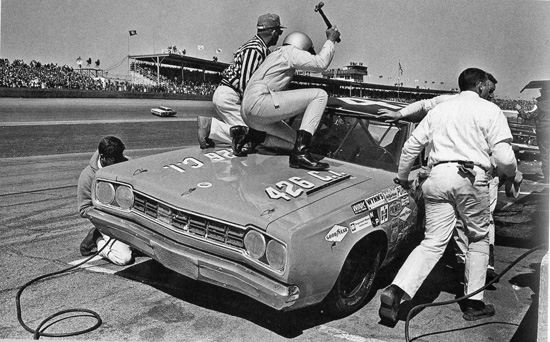
| |
| Richard gittin’ ’er dun. It was
the Daytona 500 in 1968 and the King was out of his seat and
the hammer out of the toolbox to repair a flapping vinyl
roof. A lively NASCAR official joined him on the hood. (From
NASCAR Then and Now, by Ben White with Photography
by Nigel Kinrade and Smyle Media) |
|
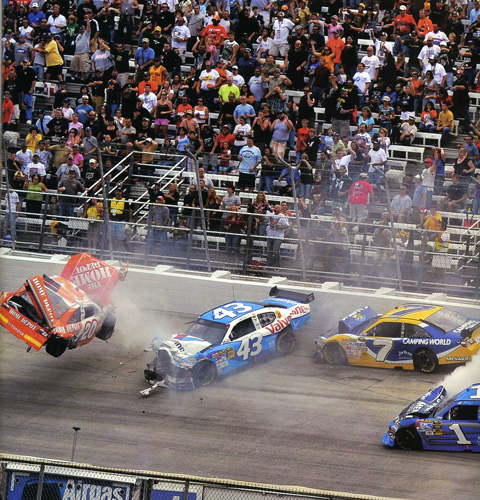
| |
| Sliced Bread on the way to the
toaster. Joey Logano follows up a tangle with Reed Sorenson,
Robby Gordon, and Martin Truex Jr. with several rollovers at
Bristol, September 2009. (From
NASCAR Then and Now, by Ben White with Photography
by Nigel Kinrade and Smyle Media) |
|
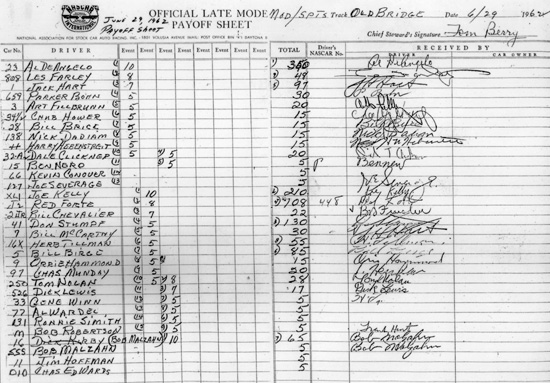
 |
< Click
thumbnail for larger view |
| How about this for
an image – and a reflection? That’s the payoff sheet from
Old Bridge (N.J.) Speedway on Sunday night, June 29, 1962.
The track drew its first class modified field of 32 from
five states, including Connecticut and Florida. It was one
of the hottest venues around, but the TOTAL purse was $1650,
with $350 going to the winner, Long Island’s very dapper Al
DeAngelo. A third of the teams had to be contented with five
bucks. (Ed Duncan Collection) |
|

| |
| It hasn’t been just oval
trackers who have experimented with motion lotions. Here
Hank Westmoreland holds tight to a jug of special tire juice
(red wine vinegar), while Don “Beachcomber” Johnson has the
hammer down in his digger at Irwindale. (From
KINGS OF THE QUARTER MILE, by Lou Hart, Tom
West Photo) |
|
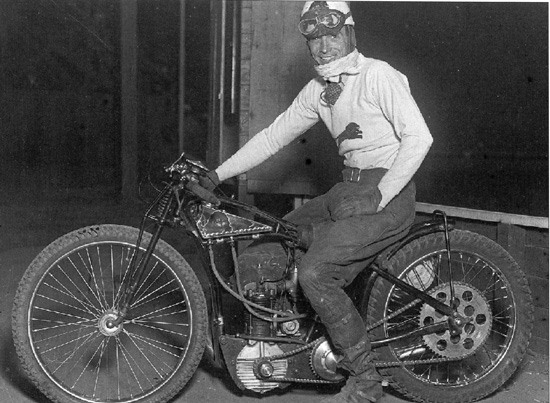
| |
| Fresno, California’s Lloyd
“Sprouts” Elder, a bike enthusiast, traveled to England,
Australia, and South America on his way to becoming a World
Champion speedway rider in the 1920s. In the early ’30s he
returned to the States, becoming the father of flat-tracking
in the US. He retired from racing in 1935 to join the
California Highway Patrol, but suffered life-threatening
injuries chasing a speeder the next year. After that, he
relied on four wheels. (From
SACRAMENTO, Dirt Capital of the West, by Tom
Motter, Jim Chini Collection) |
|
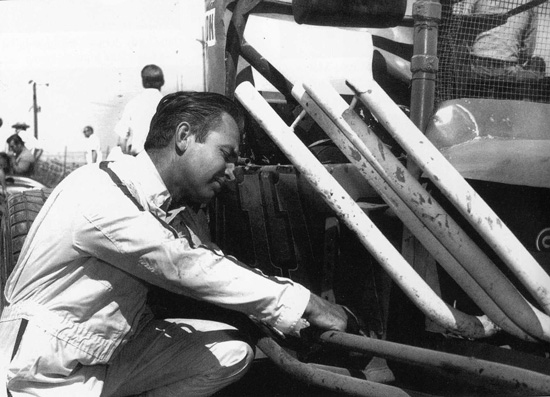
| |
| Supermodifieds have typically
been individually constructed. Here Bobby Hyde works his kit
in a February 1971 show at Manzanita. He won. Doubtful there
was a catalogue part number for those headers. (From
Thunder in the Desert, by Windy McDonald) |
|
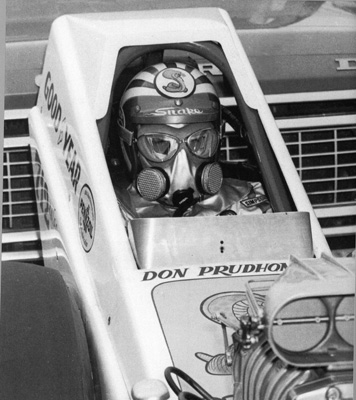
| |
| Everyone move back! Don
“the Snake” Prudhomme preps for a pass at Irwindale in his
front engine slab-side top fuel in 1971. (From
Snake vs. Mongoose, by Tom Madigan, Steve Reyes
Photo) |
|
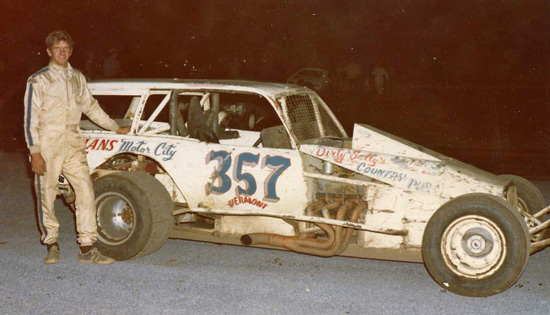
| |
Many great shoes have emerged
from those Green Mountains in Vermont, often at such ovals
as Thunder Road in Barre, Devil’s Bowl in West Haven, and
Bear Ridge in Bradford. One of the most remarkable, though,
is Clarence ”that’s why they call him Butch” Jelly. In the
mid-‘70s Butch wheeled Austin Dickerman’s cool-looking
station wagon, one of the last individualized body styles
before the dirt mods went Gremlin – and cookie cutter.
(Jo Towns Collection) |
|
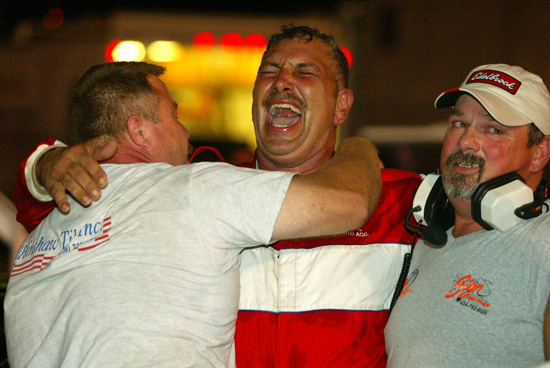
|
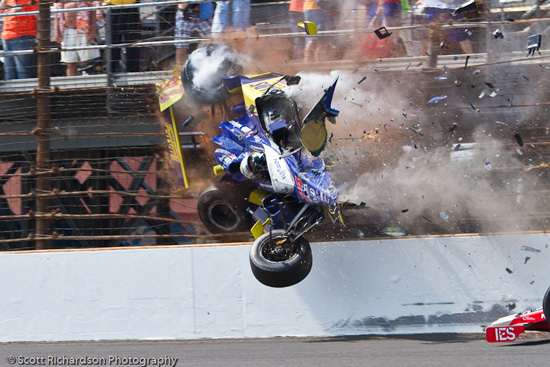
| |
|
The Full Sequence HERE
of Photographer Scott Richardson's incredible shots of Mike
Conway's wreck at The Indy 500 on 5/30/10. |
|
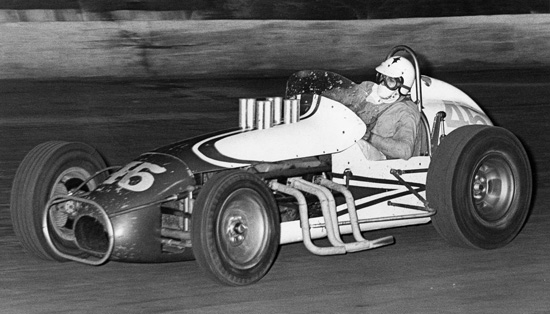
| |
| New Jersey hot shoe Ron
Passarella ran midgets and sprinters back in the sixties.
He’s shown here on the hammer at Nazareth in 1967. Hair may
have been big, but roll bars were small. (Ron Passarella
Collection) |
|
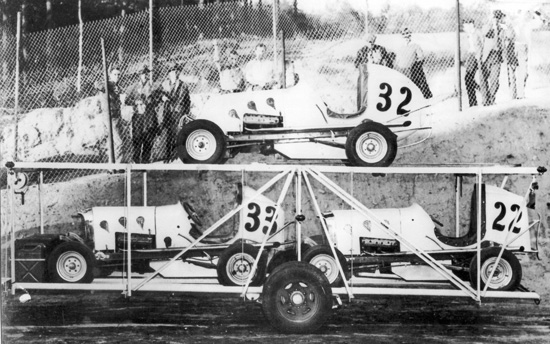
| |
| It’s a pre-war
midget race at the old Pines Speedway in Groveland, Mass.
The Nemo Russo team brought three cars. Hope they didn’t
have a trailer tire blowout on the way home! (Ed Duncan
Collection, and in
Hot Cars Cool Drivers) |
|
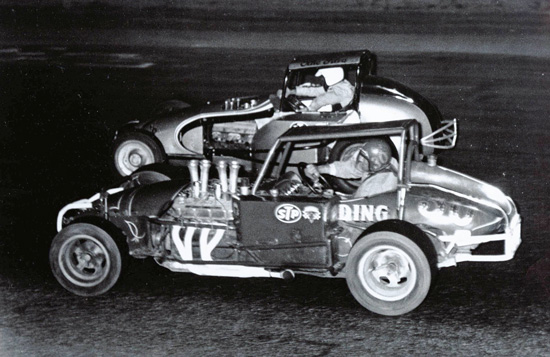
| |
| Dick Berggren captured gassers
Ollie Silva (upstairs) and Don MacLaren during their
intense, career-long rivalry in the supermodifieds. Ollie
won from Canada to Florida, Connecticut to California, while
Big Mac stayed in the Northeast. Were the two of them sawin’
the wheel or what? (Dick Berggren Photo, Russ Conway
Collection) |
|
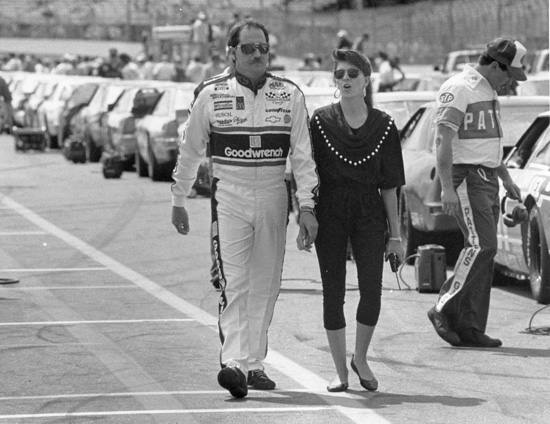
| |
| The way they were. Dale and
Theresa at New Hampshire in happier times. (Mike Adaskaveg
Photo, Dick Berggren Collection) |
|
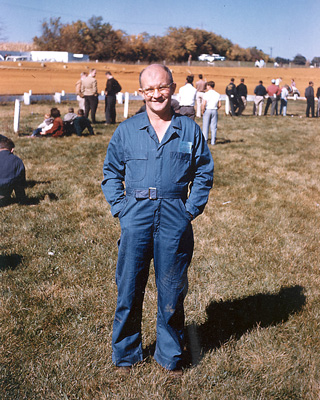
| |
| He looked so down to earth, but
he really liked it up high. The Pennsylvanian often ventured
out beyond the cushion to rack up an all-time record for AAA
and USAC sprint car wins at 103. Tommy Hinnershitz died of
natural causes in 1999 at age 87. (Dale Snyder Collection) |
|
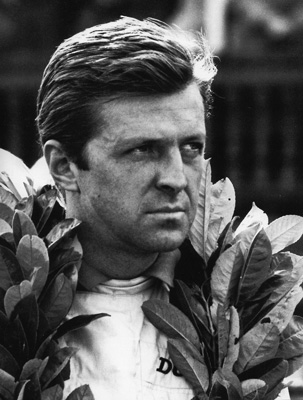
| |
| Wolfgang von Trips
had the look of aristocracy, and that he was. Count von
Trips spoke four languages and managed his family’s estates
during the week. On the weekend, he was focused on trying to
become the only German F1 World Champion. In this image, he
also has the look of unease. Maybe he had a premonition. On
September 10, 1961, he started on the pole at Monza, but he
collided with Jimmy Clark and plowed into the crowd, killing
himself and many spectators. (From
Grand Prix Racers, Portraits of Speed, by Xavier
Chimits, Photo by Bernard and Paul Henri-Cahier) |
|
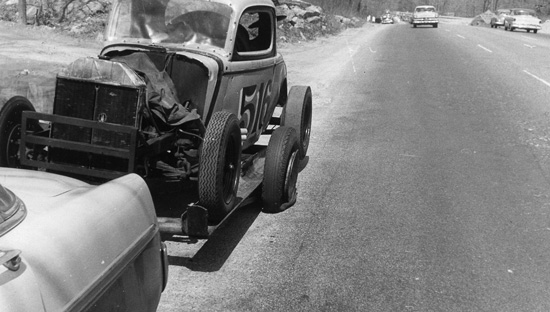
| |
| It was 1956. Trigger
Watson was out there somewhere with his Northeastern
cutdown. Some things never change. (Watson Family
collection) |
|
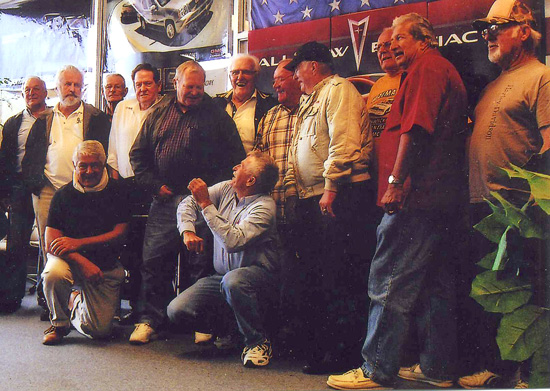
| |
| Here’s a group that belongs on a
Post Office wall. It’s the Norwood (Mass.) Arena Reunion a
couple of years ago. Left to right: Mike McClelland, Bert
McNamara, Jerry Capazzoli (kneeling), unknown, Bill Slater,
Bugsy Stevens, Dave Dion (kneeling), Leo Cleary, George
Summers, the late Ernie Gahan, the late Marty Bezema, George
Savary, and Jim Buck. And that represents a ton of feature
wins! (Mike McClelland photo) |
|
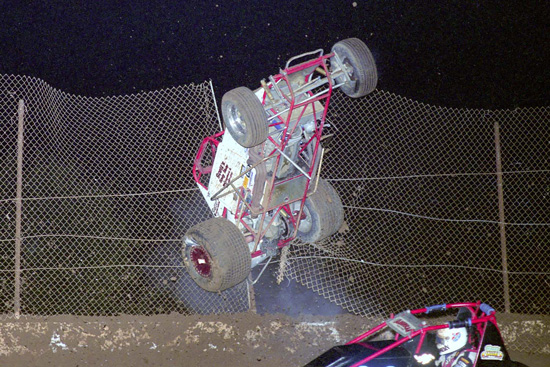
| |
| Kevin and Allen Horcher, the
racing-brother photography team, have recorded open wheel
racing action all over the country. Here Donnie Gentry’s #2
sprinter gets one great bite off the catch fence in a race
at St. Francois County Raceway in Farmington, MO, in August
of 2002. Remarkably, Donnie was OK. (Kevin Horcher Photo)
|
|
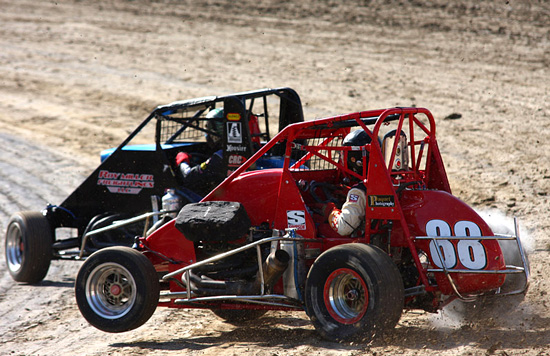
| |
Talented California lensman Jon
Paquet captures the essence of USAC midget racing at Santa
Maria Speedway this past May 15.
(Paquet Photography) |
|
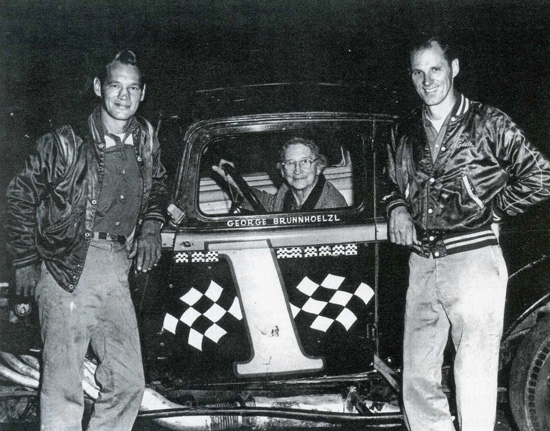
| |
| For years and years Long Island
was a veritable hot bed of racing. One of the hottest family
names was Brunnhoelzl. That’s Ma Brunnhoelzl in the coupe
with her boys George and Eddie back in 1972. (Ken Spooner
photo from
LONG RIDE ON A SHORT TRACK by Ken Spooner.) |
|
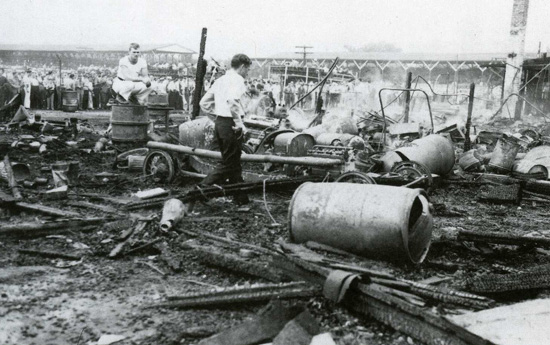
|

| |
| Thirty years ago, John Andretti
went to the Dorney Park banquet to collect some hardware.
Uncle Mario went, too. (Dale Snyder Collection) |
|
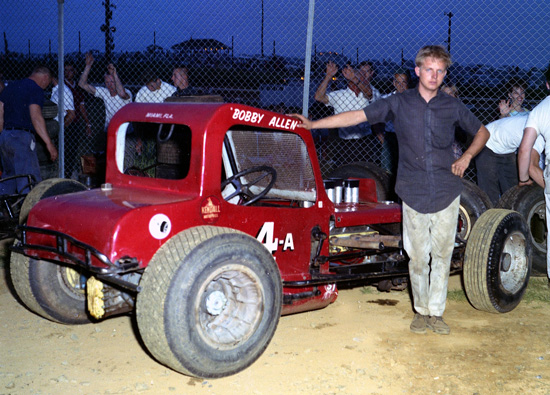
| |
| It’s the height of
the summer, June 24, 1966, and a young Floridian transplant,
Bobby Allen, is already looking a little scruffy at Williams
Grove. But he sure had a pretty early super. (Dale Snyder
Collection) |
|
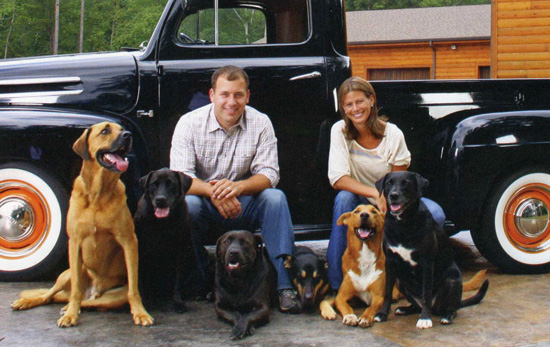
|
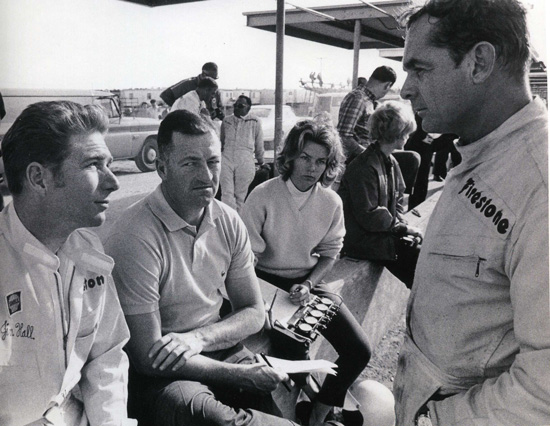
| |
Part of the Chaparral team, one
of America’s greatest ever, in 1967. Left to right are Jim
Hall, co-driver Hap Sharp, Sandy Hall, and Phil Hill.
(John Lamm photo from
PHIL HILL- A Driving Life, by Phil Hill.) |
|
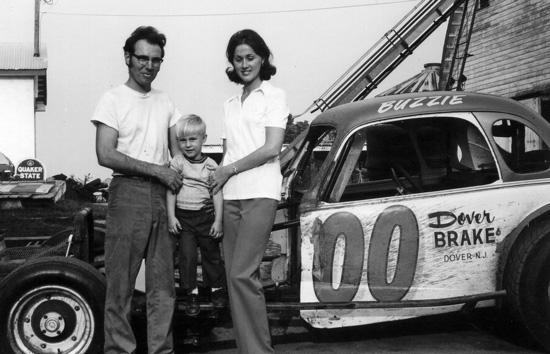
| |
| It was Northern New
Jersey, back in the early seventies. That’s Buzzie Reutimann
with his bride Linda and their already famous Dover Brake
#00. And you guessed it. The little guy is David. (Berggren
Collection). |
|

| |
| That’s one of New York’s state’s
favorite racers, Kenny VanWert, giving Debbie Welch some
instruction before she attacks the mile at New Hampshire
Motor Speedway in the Coastal 181 coupe at a Vintage event
several years ago. Deb is a real trouper, as you can see.
The two of them are attacking the altar on June 12, and
everyone wishes them the very best. (Danny Wood Photo) |
|
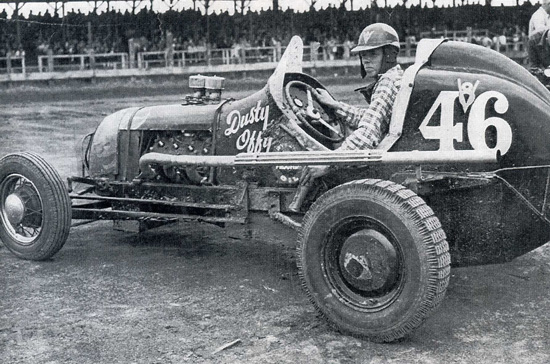
| |
| Harley Lafary looks a tad
subdued before the start at Aledo, IL, in September of 1950.
Someone may have been confused, too. His Dusty Offy is
powered by a Ford Flathead. Harry Lafary collection from
RACING THE HEARTLAND – A History of the MVARA, by
Ken Paulsen. |
|
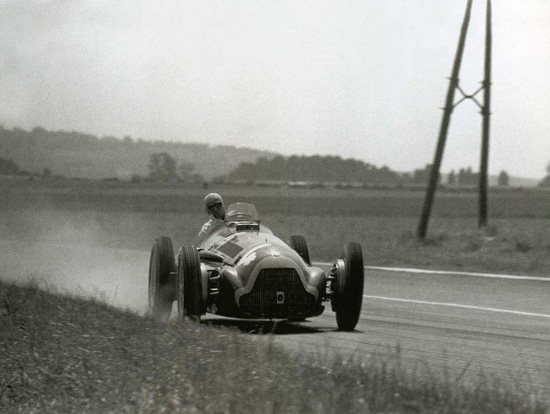
| |
| Don’t you wish you could have
seen him drive? Juan Manuel Fangio negotiates the French
Grand Prix in Reims, July 1, 1951 in a classic drift. The
Klemantaski Collection from THE
EYE OF KLEMANTASKI. |
|
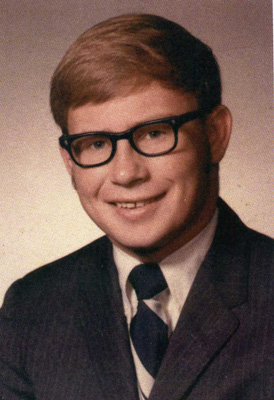
| |
| That’s a high school senior who
said he was “facing the big ol’ world without a clue.” He
was Doug Wolfgang. Wolfgang Collection, from
LONE WOLF by Doug Wolfgang with Dave Argabright. |
|
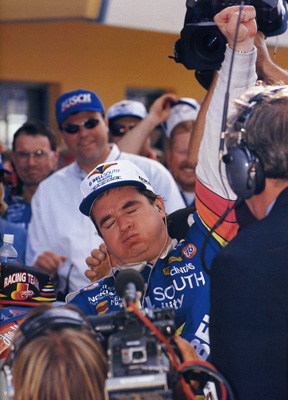
| |
| Joe Nemechek was noticeably and
understandably emotional after his Busch win at Homestead on
November 9, 1997. His brother had died in a truck race at
that track eight months earlier. Phil Cavali Photo from
SECOND TO NONE – the History of the NASCAR Busch Series,
by Rick Houston |
|
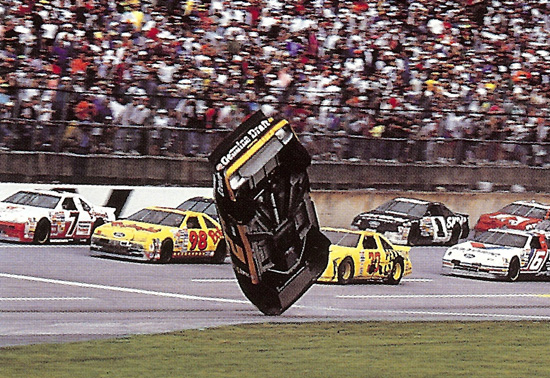
| |
In the Spring Talladega race in
1993, Rusty Wallace tangled with Dale Earnhardt and took
this heart-stopping tumble across the line for a sixth-place
finish. He flipped about ten times, and the violence of the
wreck inspired Don Miller of Penske South to launch the
project that resulted in roof flaps for Winston Cup cars.
From
Miller’s Time – A Lifetime at Speed.
(Jeff Robinson Photo). |
|
 |
|
On and off during the course of the
next few months we will be posting photos taken by Coastal
181 writer Joyce Standridge (GOTTA
RACE! with Ken Schrader),
INSIDE HERMAN’S WORLD with
Kenny Wallace,
WIN IT OR WEAR IT on sprint
car racing) and her ultra-competent racer husband Rick.
These are informal but informative candid shots of all kinds
of racing, and we are grateful to have and be able to share
them. |
|

| |
|
In March 1972, the USAC sprint
cars opened the season at Queen City Speedway near
Cincinnati.
The half-mile track was wicked fast that afternoon, even as
the cars struggled to warm up to good operating temperatures
in the very cold air. Little did we know that only two
months later the dirt would be paved over. By the end of the
80s, the track disappeared altogether. (Joyce Standridge
photo)
|
|

| |
|
When late
models went crazy in the early 1980s with the Wedge and all
sorts of alien aftermarket parts, a number of efforts were
made to try to rein in the technological binge–and the
attendant costs. One of the few that was successful was the
United Midwestern Promoters (UMP), who hired Bob Memmer of
Evansville,
Indiana,
(pictured in 1988) to be the face and voice for the
organization. For a long time, Bob traveled from track to
track, taking no pay and often sleeping in his car. In spite
of constantly being caught between racers (the rock) and
promoters (the hard place), Bob earned respect from day one
and went on to be regarded as a genuine voice of reason.
Eventually, poor health sidelined him and, at the relatively
young age of 69, Bob passed away on July 8, 2004. (Joyce
Standridge photo)
|
|
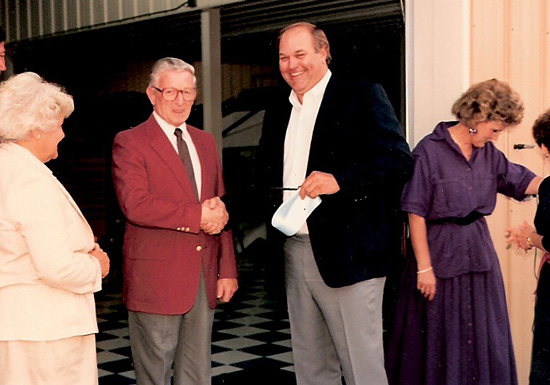
| |
| Sprint car chassis companies
come and go, but Maxim has managed to not only hang around,
they've been among the top-tier builders since 1989 when
they opened their doors to customers. Here Springfield,
Illinois, Mayor Ossie Langenfelter (sans his 10 children)
congratulates Maxim owner Chuck Merrill at the grand
opening. Merrill had made a tidy fortune building roads, but
he went from a car owner to car builder because he believed
he could do it better than most were doing it at the time.
Clearly, he was correct. And he knew how to get a little
fanfare for his business, unlike most back-of-the-garage
constructors. (Joyce Standridge photo) |
|
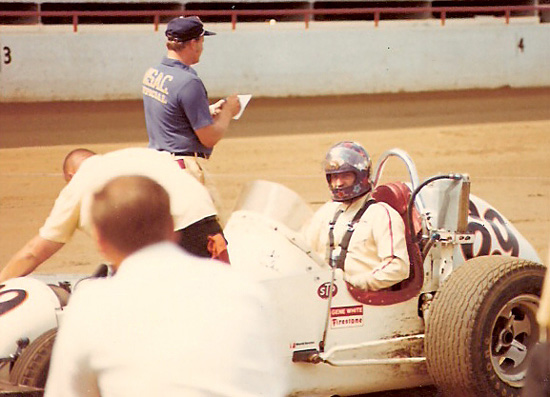
| |
| Sidney, Ohio's Duke Cook was a
real character. On and off track his wild-man ways garnered
him lots of attention, and few race drivers were more fun,
but it probably hampered his career. And it meant that he
took rides other people steered away from. Here, he is
readying to qualify at DuQuoin in 1971, and yes, that roll
bar was legal at the time. Full cages had become the norm,
although many of them were still bolted-on to older chassis
rather than welded on, but a few stubborn car owners did no
more than was required–hence the roll bar rather than a
cage. Flips on the one-mile dirt track were not uncommon,
which is why there have been several fatalities and a lot of
injuries over the years. It's still one of the very best
tracks in America to watch 100 miles of dirt champ or stock
car action while the unmuffled engine noise rattles your
brain under the roof of the grandstand. (Joyce Standridge
Photo) |
|
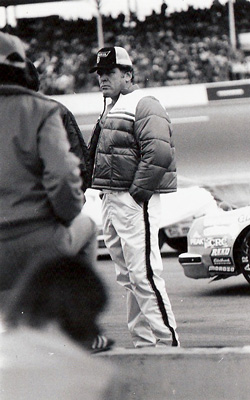
| |
| Speed Weeks 1980 was one of the
coldest, wettest ever. Somehow, Daytona got every race in
without delay, but not without a lot of breath-holding.
Buddy Baker donned a coat and nervously paced prior to the
Twin 125s, understandably since he was driving Harry
Ranier's Gray Ghost, clearly the fastest in the field. And
the following Sunday, Baker finally had a car that held up
under his relentless, heavy right foot. Not only did Baker
win the 500, but set a speed record (2:48:55; 177.602 mph)
that stands until today. And every one of the frozen chosen
who were there that day was forever grateful to Baker for
the blistering pace! (Joyce Standridge photo) |
|

| |
| Before there was Roger Penske
and Chip Ganassi as the preeminent powers of Indy car
racing, there were Parnelli Jones and Vel Melitich, who were
partners rather than adversaries. Melitich was a very
successful California car dealer who decided to go Indy car
racing. With Parnelli, they won the 500 and went on to be
business partners in a number of ventures in and out of
racing. Even in a successful car-owning career, the duo
exceeded everyone's expectations by not only winning but
also figuring out one of the all-time great marketing
schemes–the Johnny Lightning Special, which launched
Matchbox cars in the early 1970s. With Al Unser behind the
wheel, they were the team to beat, and every little racing
boy's idols. (Joyce Standridge Photo) |
|
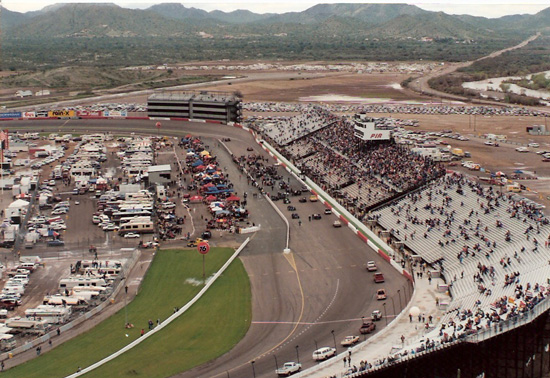
| |
The Copper World Classic dates
back to 1976, and these days is held in November, but for
many years the Phoenix International Raceway multi-class
racing event was a late-winter excuse to escape the snow
banks and bask in the sun for a long weekend. During most of
its history the event has been a four-class, USAC-sanctioned
opportunity to see youngsters on their way to the big time
and nearly always one or two who ran more than one class at
a time. The midgets, dirt champ cars, supermodifieds and
stock cars promised that if one race was a stinkeroo,
another one would be a great old barnburner. You could count
on getting your money's worth. If you could get to the
track, because in 1993, flooding in the area was so bad that
there was only one road in and out to the remote track, and
the entire parking lot next to the track was under water.
(Look off to the upper right of the grandstand photo.) Yes,
it did affect the crowd as a lot of locals had to stay home
and bail water.
(Joyce Standridge photo) |
|
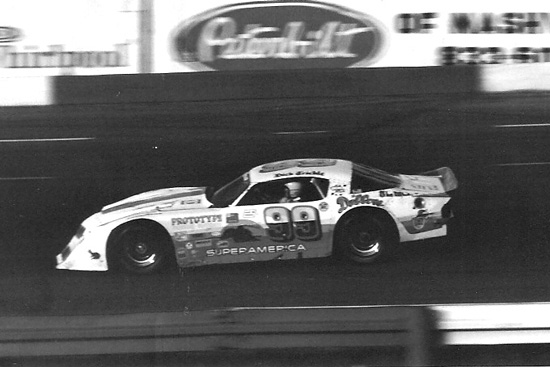
| |
| Maybe racing's most
interesting–and prolific–winner, Dick Trickle in the
mid-1980s at Nashville at the All-Pro 400. Within a couple
of years, NASCAR would beckon, and while Trickle would never
enjoy the success there that he did on the way to an
estimated 1,000 short track outlaw wins, he would always be
one of the great guys on and off the track. He lent his name
to a bad-movie character (Cole Trickle in "Days of Thunder")
and a thousand really bad jokes (c'mon, who can't come up
with bathroom humor), but the fact that he never won a
NASCAR race was a cruel coda to a brilliant career. Note
also the name "Dillon" over the rear tire cut-out. That's
Mike Dillon, who was one of just a couple incredibly
successful pavement chassis builders of the era. Mike is now
general manager for father-in-law's Richard Childress
Racing, and father of promising young driver Austin Dillon.
(Joyce Standridge photo) |
|
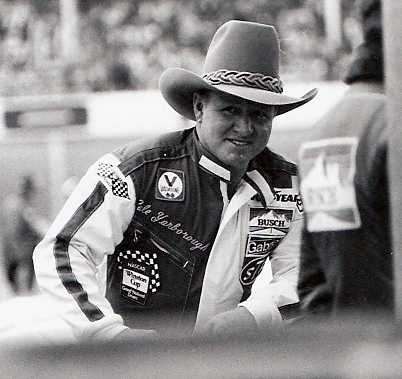
| |
|
You have to
be of a certain age to remember when nearly everybody at all
the race tracks was wearing a cowboy hat. Drat that "Urban
Cowboy" movie, but coming off the disco look, it worked a
whole lot better at the track. Nobody at any track wore a
hat bigger than Cale Yarborough's, and we don't think it was
because he was one of the shorter drivers around either. Or
trying to make up for any other deficiencies, either
because, frankly, he didn't appear to have any. Yarborough
was the only NASCAR driver to run off three straight
championships (1976-1978) prior to Jimmie Johnson's recent
string. Yarborough also won 83 races (5th all-time); four
Daytona 500s (1968, 1977, 1983 and 1984), and took on Donnie
and Bobby Allison in a fist fight at the conclusion of the
1979 live Daytona 500 telecast to launch the modern era. It
was a fair fight because Yarborough had been a real boxer.
Yarborough was a forerunner of drivers like Tony Stewart and
Kyle Busch in racing all kinds of cars throughout his
career, including Indy cars and dirt late models. Today, he
is a very successful businessman in his native
South Carolina.
(Joyce Standridge photo)
|
|
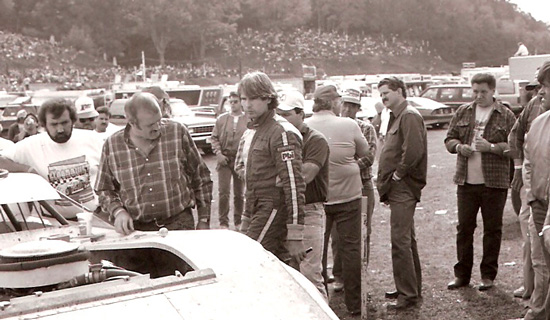
| |
| It was 1983 at the Dirt Track
World Championship in Pennsboro, West Virginia, and it was
already clear that wherever Scott Bloomquist (center in
driver's suit) shows up, so will lots of rubberneckers.
Bloomquist had moved from California to Tennessee less than
five years earlier but was already a traveling late model
star. And he has been consistent through the years–he had no
more patience for most of the press and the other
rubberneckers then than he does today. Whether you love 'im
or not, you have to admit that few people have ever figured
out race cars more thoroughly or driven more intensely.
(Joyce Standridge photo) |
|
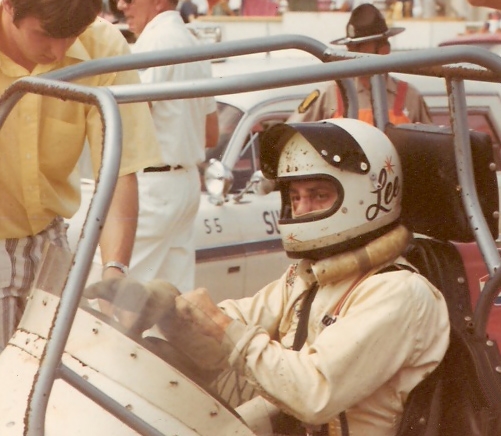
| |
The only race driver to come out of tiny
Guttenberg, Iowa, Lee Kunzman was on the way to a brilliant
Indy career when he suffered horrific third-degree burns in
a sprint car crash at I-70 Speedway. After excruciating
rehab, Kunzman fooled all the naysayers by coming back to
racing, here in 1971 at DuQuoin. But the scars from the fire
were still a clear reminder of what can happen in racing.
Kunzman went on to race at Indy, although not at the level
that the early promise had shown. Smart as a whip, he became
a team manager and today is vice-president at Hemelgarn
Racing.
(Joyce Standridge photo) |
|
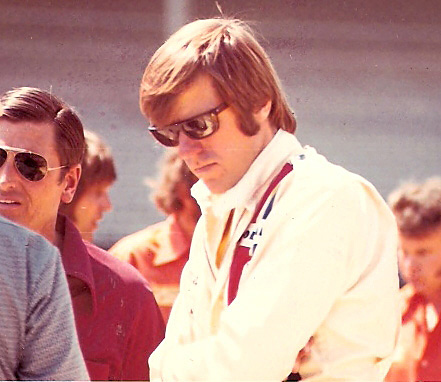
| |
Mike Hiss wasn't the first
pretty boy at Indy, but he was the first to take his looks
in a direction no other race driver before him had done:
Hiss took off his clothes and was the first centerfold for
Playgirl's preview issue in January 1973. Fully dressed
here, Hiss was nervously attempting to make his first Indy
500 in 1972. He made it, starting 25th and finishing 7th. He
didn't look so nervous in Playgirl. Or so I'm told.
(Joyce
Standridge photo) |
|

| |
|
One of the finest human beings to
ever walk into a race track, Anton "Tony" Hulman. On this
day, he was a guest at DuQuoin's dirt track, and even though
it was a typically dusty day, Mr. Hulman remained neat as a
pin. As then-owner of Indianapolis Motor Speedway,
especially with the Indy cars as the premier league of
racing in that day, Tony Hulman was the most powerful man in
auto racing. And yet, he was not only accessible, he
actually sought out unimportant folks for conversations
about what they enjoyed most in racing. I was one of those
people, and I will always treasure that 15-minute
conversation. (Joyce Standridge photo)
|
|
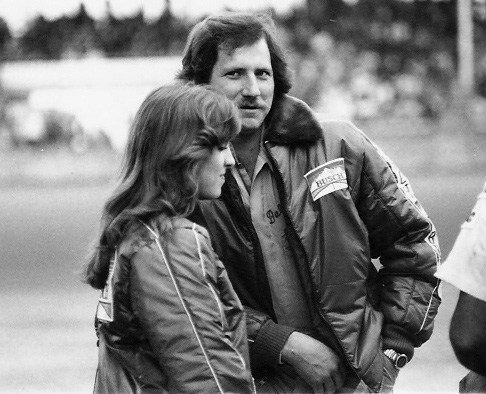
| |
| By the end of 1980, Dale
Earnhardt Sr. would pocket the first of his seven NASCAR
championships, but that February he and girl friend Teresa
Houston were still pretty much flying under the radar. After
this photo was taken, he actually came over to the pit wall
and allowed himself to be interviewed, something that would
never have happened even a couple of years later. But from
the beginning, he was a tough interview, although it seemed
to me to be from shyness and insecurity in the early days.
Not long after, he realized that he was as smart as anybody,
more capable than most of coming up with an intelligent
question, and a lot of same (dumb) questions got asked over
and over, so what was the point? In early 1980, he wore his
hunger for success like a badge–and it was immensely
likable. (Joyce Standridge photo) |
|
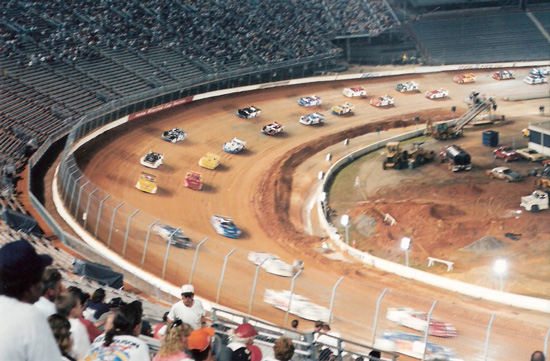
| |
|
In 2000,
Bruton Smith innovated once more–and only once, in this
case–putting over 8,000 cubic feet of red clay dirt on the
Bristol Motor Speedway. Late models came from everywhere to
have the chance to say they'd driven the track's high banks,
even though the dirt was at 22-24 degrees instead of the
pavement's then-36 degrees (it's 24-30 degrees since
repaving). The track was so incredibly tacky that many late
models could not keep wheels under the cars and axles were
snapping almost every lap. Eventually, a full field was
pulled together for a feature, but most racers had dug deep
into the trailers for sturdier suspension assemblies. Sprint
cars ran there twice, in 2000 and again in 2001, but the
too-fast track was just too much for the short trackers, and
even with excellent crowds on hand it hasn't been repeated.
(Joyce Standridge photo)
|
|

| |
| Racing has always been home to
characters. Few short trackers have been more colorful than
Jungle Jim Davison, who was better known in the Midwest in
the 1970s and 1980s for his antics than for wins. He has
said he regrets that he didn't try harder to put together
winning combinations or get better rides, but he has never
regretted having more fun than almost anybody–and dragging
his unsuspecting friends into many an ornery practical
trick. Like spritzing people with water from a fire
extinguisher when they were worried about rain moving into a
track, and then sitting back to laugh as they would
hurriedly load up–only to find out the rain was phony.
Jungle now owns a very popular racing-themed restaurant in
Springfield, Illinois, where many, many bench races are run
every day. Oh, and his jack technique never really caught
on, for some reason. (Joyce Standridge photo) |
|

| |
| Rick Standridge at
“Little Springfield” back in the early ‘70s. That’s one
special CAE car. Just ask Rick’s wife, writer Joyce
Standridge. She’s a good sport. They spent their courtship
rebuilding it with Rick in a garage that didn’t know about
heat. Photo – Standridge Collection. (See
WIN IT OR WEAR IT – All-Time Great Sprint Car Stories
by Joyce Standridge) |
|
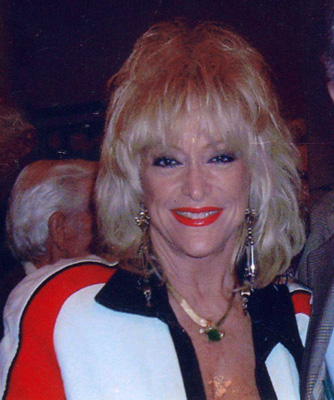
| |
| Linda Vaughn at Daytona a year
ago. Still the best! (Bill Harman photo) |
|
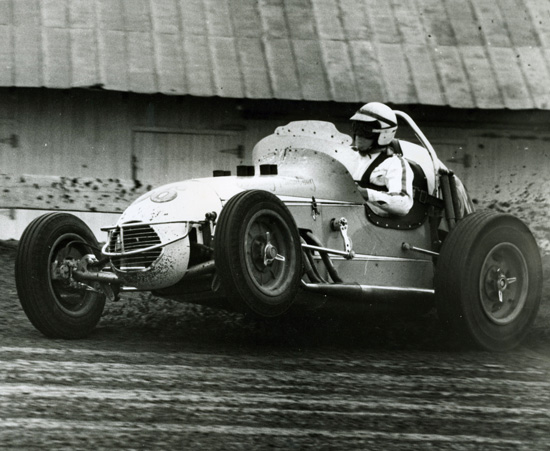
| |
|
Jim Hurtubise, looking calm as
a cucumber, has his sprint car all jacked up at Williams
Grove in 1961. There is some great footage of Herk on Dale
Snyder’s video,
Open Cockpit Classics.
Dale Snyder Collection and his life story is told well in
Herk Hurtubise, by Bob Gates. |
|

| |
| That’s Benny Howard on his way
out of the park in a 50-lapper at Twin Oaks Speedway in
Gulfport, Mississippi, back in 1975. Sammy Swindell is
sneaking by on the inside. Photo by Chuck Hendricks from the
collection of Gerald Hodges (author of
Southern Super Modifieds). |
|
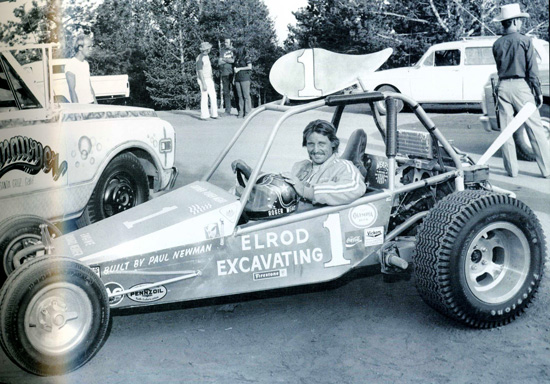
|

|
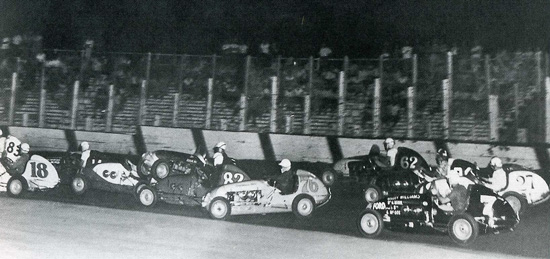
| |
| It was tiny – just a fifth-mile,
but Kansas City’s Olympic Stadium is huge in midget history.
It was dirt, carved out of the Blue River bottomlands. A.J.
Foyt captured his very first USAC win there in the spring of
1957. From
LOST RACE TRACKS – Treasures of Automobile Racing,
by Gordon Eliot White. (Bill Hill Photo) |
|
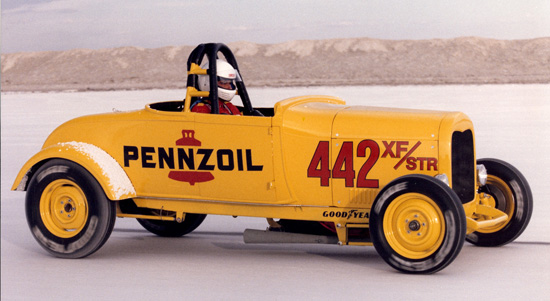
| |
| Hemmings Senior Editor Jim
Donnelly just finished a memoir of Don Miller for Coastal
181. That Don is one serious car guy. Other than starting
Penske Racing South, developing the roof flap, and mentoring
drivers like Rusty Wallace and Ryan Newman, Miller did some
racing of his own. Early on he was a professional drag
racer. In the nineties he adapted this street rod for
Bonneville. He set a land speed record for flatheads at over
150mph, still spinnin’ the tires. From
MILLER’S TIME – a Lifetime at Speed, by Don Miller
with Jim Donnelly. (Miller Collection) |
|
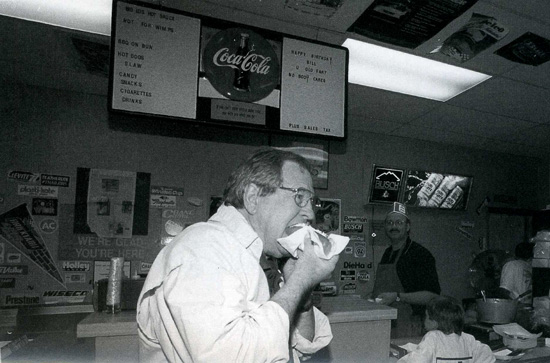
| |
| Bill France Jr. seemed much more
down to earth than some of NASCAR’s current management. Here
he’s feasting on his birthday on what Herb Branham calls
“his favorite delicacy – the hot dog.” From
BILL
FRANCE JR. - THE MAN WHO MADE NASCAR, by H.A.
Branham. |
|
|
|

| |
| Junior Johnson got all dressed up
for Victory Circle at Asheville-Weaverville Speedway in
August of 1961. Looks like the track conditions were not to
spiffy, either. From
REAL NASCAR by Daniel S. Pierce (Don Hunter Photo) |
|
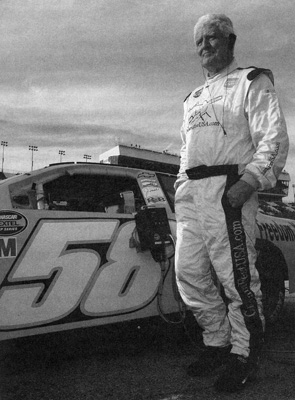
|

| |
|
Ben Affleck and Whoopi Goldberg
were grand marshal and honorary starter for the 2004 Daytona
500. From ONE HELLUVA RIDE – How NASCAR Swept the Nation
by Liz Clarke. (Getty Images Photo)
|
|

| |
|
The
roaring roadsters were essentially early supers, quick and
open-aired.
As this image
from the third mile San Jose Stadium in 1949 would indicate,
they did not necessarily handle like a go kart.
Look at those guys wrestling with the steering
wheels! From
HISTORY OF
SAN JOSE
AUTO RACING 1903-2007.
(Reginald McGovern Photo)
|
|

| |
|
San Jose Speedway in 1981 was
the home of huge wings. That year the track was also
said to have the largest weekly attendance west of the
Mississippi.
From
HISTORY OF
SAN JOSE
AUTO RACING 1903-2007.
(Dennis Mattish Photo)
|
|
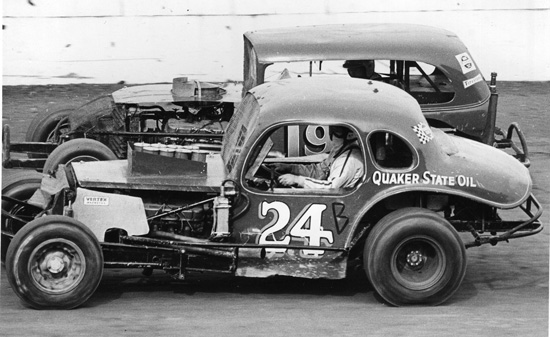
| |
|
It took
big engines and big human parts to run the East Coast dirt
modifieds in the early ‘70s.
Here are Lee
Hendrickson (inside) and Eddie Delmolino parade-lapping
before a 100-mile race.
Check out the
fuel tank in Delmolino’s coach. (Dick Berggren Photo)
|
|
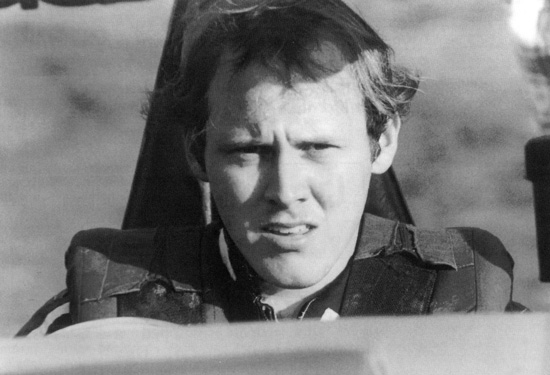
| |
| Brad, Bart, and Todd Noffsinger,
the three famous racing brothers, started out with the
California Racing Association. Sadly, Todd, just 20, was
killed in a sprint car mishap at Ascot on Memorial Day
weekend, 1983. From
RACERS AT REST – the Checkered Flag 1905-2008, by
Buzz Rose, Joe Heisler, Fred Chaparro, and Jeff Sharpe.
(Noffsinger Collection Photo) |
|
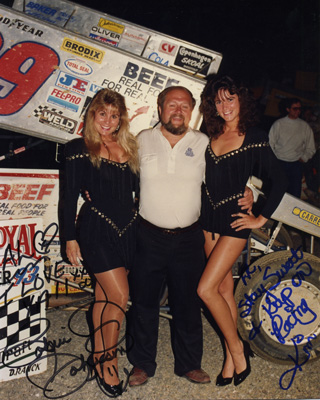
| |
Busy Al Robinson, one of
America’s favorite announcer/journalists, really had his
hands full back at “Beef Night” at Port Royal (PA) Speedway
in 1993. That’s Robin Johnson on his right and Kim Hurley to
the left.
(Arthur Ruppert Photo, Robinson Collection) |
|
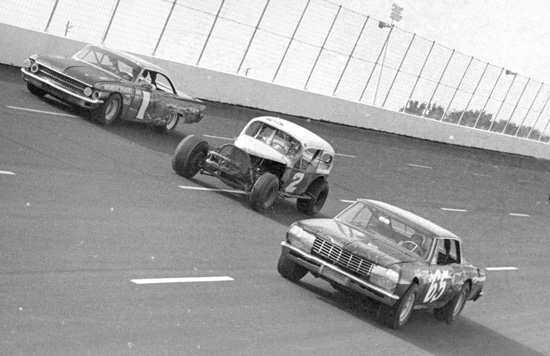
| |
|
It’s
Frankie Schneider in his legendary coach at Dover,
of all places, in 1969. Frankie raced the All Star
League shows that year and ran quite a few asphalt shows, as
far North as the old Norwood Arena. And, of course,
along the way he ran every East Coast dirt track imaginable.
(Dale Snyder Collection)
|
|

| |
| New York lensman Chris Burgess
captures a stunning shot for the ages. That’s the great,
bionic, 69-year-old Bentley Warren, comfortably settled in
the seat of a super, just as he has been for close to 50
seasons. The only thing missing is that impish, teenaged
smile. |
|
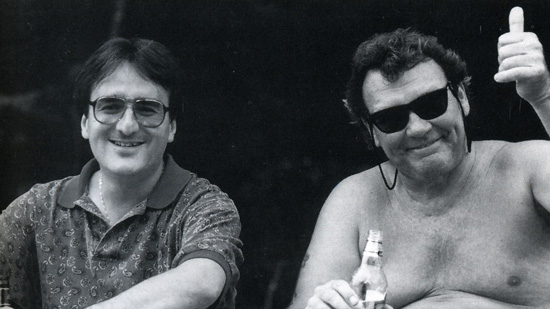
| |
| That’s another Coastal 181
author, Bones Bourcier, on the left, partying with Bill
Simpson. Yesterday we featured our author Susan Kelly Hearn.
Who do you think is prettier? From
RACING SAFELY, LIVING DANGEROUSLY, by Bill Simpson
with Bones Bourcier. (Bourcier Collection) |
|
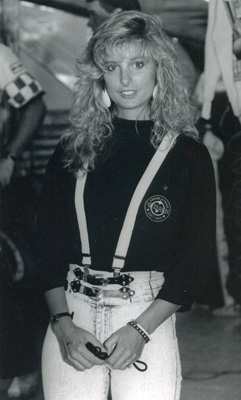
|
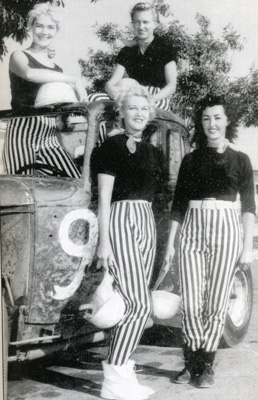
| |
| We hear so much about Danica and
Milka these days, and it seems so new. How about the
original “Lady Leadfoots” who barnstormed across Southern
California back in Jalopy days? In front row (right) is
their leader, Hila Paulson, and on left is Vicky Jones. In
back on right is Lorraine Gwynne and on left is the quickest
of them all, Mary Jo Erikson. From
MEMORIES OF THE CALFORNIA JALOPY ASSOCIATION, by
Thomas D. Luce.
(Hila Sweet Collection) |
|
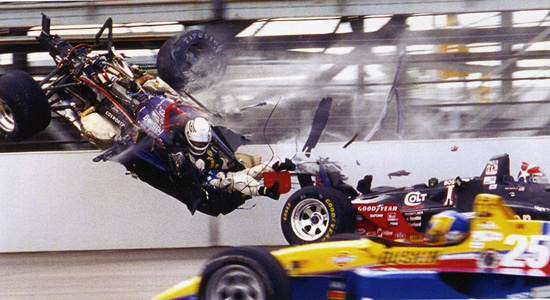
|

| |
| Folks didn’t have much of a clue
about the real dangers of smoking back in 1980. How about
the dude in the hat, cigarette hangin’ out of his mouth,
unbuckling Eddie Leavitt after a crash at DuQuoin. Look at
the fuel tank! From
WIN IT OR WEAR IT – All-time Great Sprint Car Tales,
by Joyce Standridge. (Kevin Horcher photo) |
|
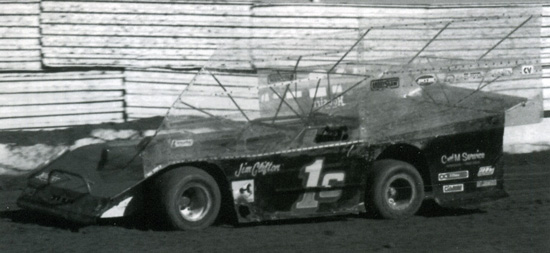
| |
| It was the Snow Bird Classic,
November 19, 1989, an open-comp Late Model show at the now
shuttered Manzanita Speedway. Jim Clifton won it in his #1c
after a rousing duel with Robbie Unser. Did Clifton have the
aero workin’ or what! From
MANZANITA SPEEDWAY’S DESERT THUNDER 1981-2005, by
Windy McDonald. (CIG photo) |
|

| |
Monza! Can you imagine? Tony
Bettenhausen once qualified at 177mph in an Indy car on
those haunting high banks that sit today idle under the
Italian sun. From
Speedway - Auto Racing’s Ghost Tracks, by SS
Collins and Gavin D. Ireland.
(Gavin D. Ireland photo) |
|
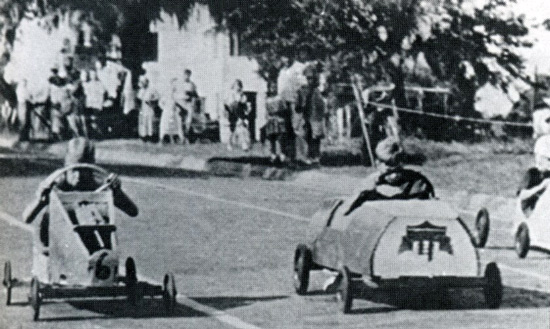
| |
|
Those boys
were lookin’ intense in the Dade City (FL) soap box derby in
1950. They still are. It’s Will Cagle and Wayne
Reutimann. From
FLORIDA
MOTORSPORTS RETROSPECTIVE PICTORIAL,
by Eddie Roche.
(Bruce Craig Collection)
|
|
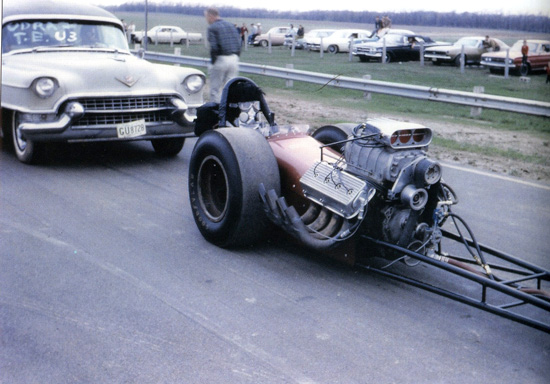
| |
|
That Caddy was pretty neat.
So was that Midwest UDRA rail-job driven by Duane Nichols.
But coolest of all is what they called the dragster – “Nitroholic.”
From
KINGS OF THE QUARTER MILE, by Lou Hart.
(Don McReynolds photo)
|
|
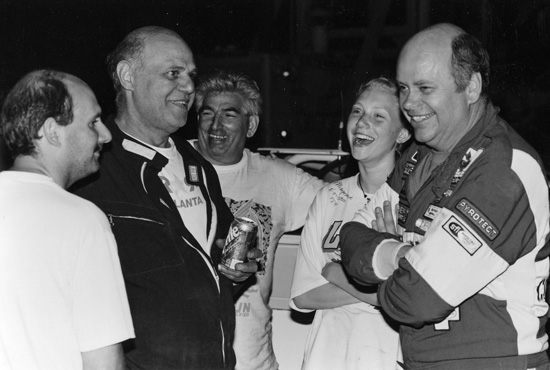
| |
|
Happier
times. Left to right, it was Peter Lazzaro; the
legendary Lou “Monks” Lazzaro; Lou’s long time wrench,
Junior Bianco; Melissa Lazzaro, and Dave Lape. One of
the greatest East Coast modified drivers ever, Louie died
after a race at Fonda (NY) Speedway
ten years ago. On Saturday, May 15, the track will
host a major memorial event for him. Dave Lape will be
on hand, hoping for that checkered flag. Along with it
will come the Coastal 181 Cup.
(Dick Berggren Collection)
|
|
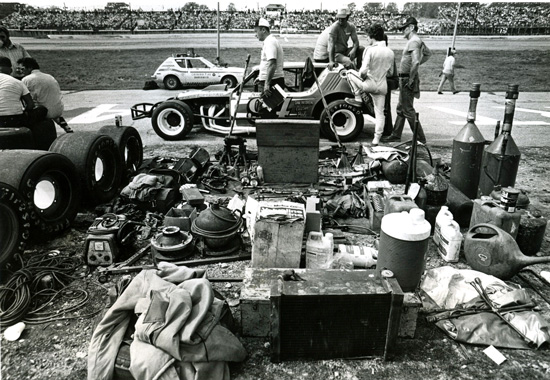
| |
Rit Patchen, a big star at the
old Danbury (CT) Speedway, used to come up to Thompson
Speedway for the big extra-distance shows. Rit and his crew
sure were ready, but what would Chad Knaus have said about
this pit layout?
(Dick Berggren Collection) |
|
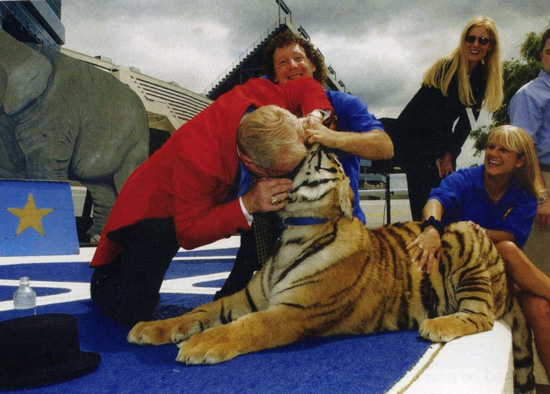
|

| |
|
Out sideways, right rear
smoking. The guy was amazing. That’s Paul Newman
in 1997, hardly then a kid, in Ron Shuman’s sprinter at
Perris (CA)Speedway. From
WINNING – The Racing Life of Paul Newman, by Matt
Stone and Preston Lermer (Mike Arthur
Photo)
|
|
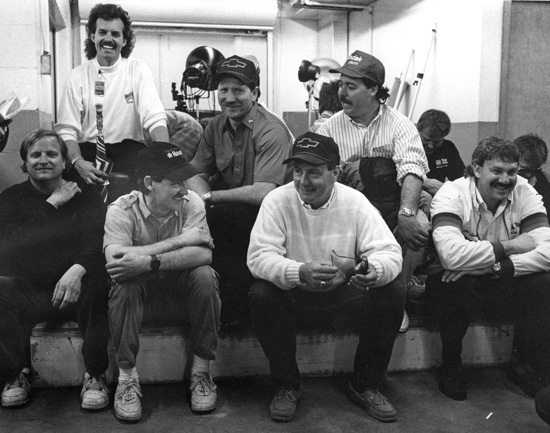
| |
A jolly band, not so long ago.
(L-R, Top) Kyle Petty, Dale Earnhardt Sr., Ernie Irvin, (L-R
Bottom) Marc Reno, Davey Allison, Ken Schrader, and Dale
Jarrett
(Dick Berggren Collection) |
|
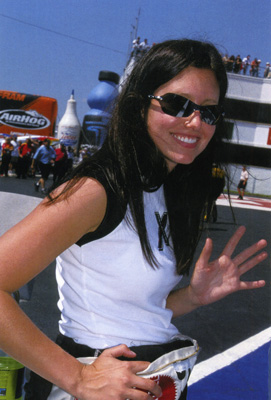
| |
In 2004,
when this photo was taken, John Force was keeping a close
eye on his daughter Ashley. At the season-ending NHRA event
that year, they each won their class, becoming the first
father-daughter event winners in drag racing history.
From
JOHN FORCE, the Straight Story of Drag Racing’s 300mph
Superstar,
by Erik Arneson (Jon Asher photo) |
|
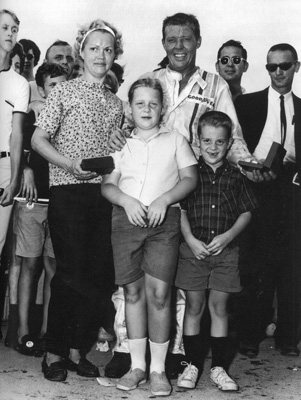
| |
| Red Riegel
and his family, following a fifth place finish at the
Hoosier Hundred in 1965. On June 10 of the following year he
and Jud Larsen were in a dual sprint car fatal at Reading,
(PA) Speedway.
From
DAMN FEW DIED IN BED by Andy Dunlop and Thomas Saal
(Bruce Craig photo) |
|
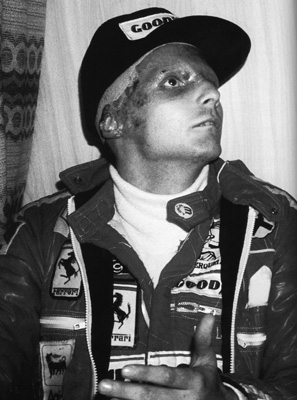
| |
Niki Lauda suffered horrific burns in
his Ferrari at Nurburgring in 1976. He was read his last
rites on the way to the hospital. Five weeks later, he was
back in a race car.
From
GRAND PRIX RACERS, Portraits of Speed, by Bernard
Cahier and Xavier Chimits (Bernard Cahier photo) |
|
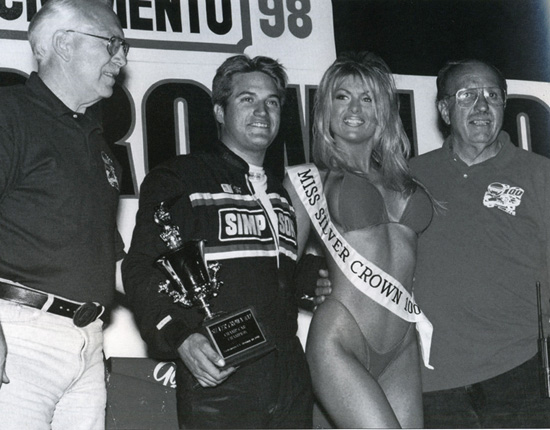 |
| |
You don’t hear J.J. Yeley’s name
that much these days, but he is one remarkable racer. He’s
had some pleasing days at the track, including this one at
the Sacramento Silver Crown 100 in 1998.
From
SACRAMENTO, Dirt Capital of the West, by Tom Motter
(Dennis Mattish photo) |
|
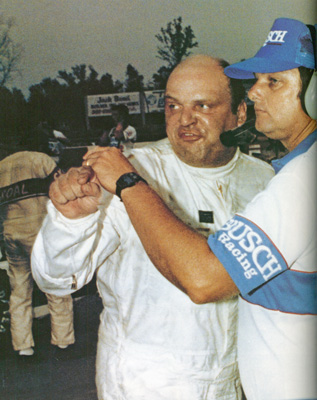
|
|
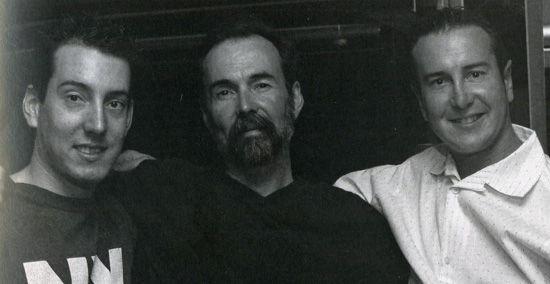
We bet you
did not immediately recognize Kyle and Kurt Busch’s
Dad, Tom.
This unusual image is from Anita Rich and
Robin Dallenbach’s book,
PORTRAITS OF NASCAR.
|
|
BACK
TO PHOTO OF THE DAY HOME PAGE |